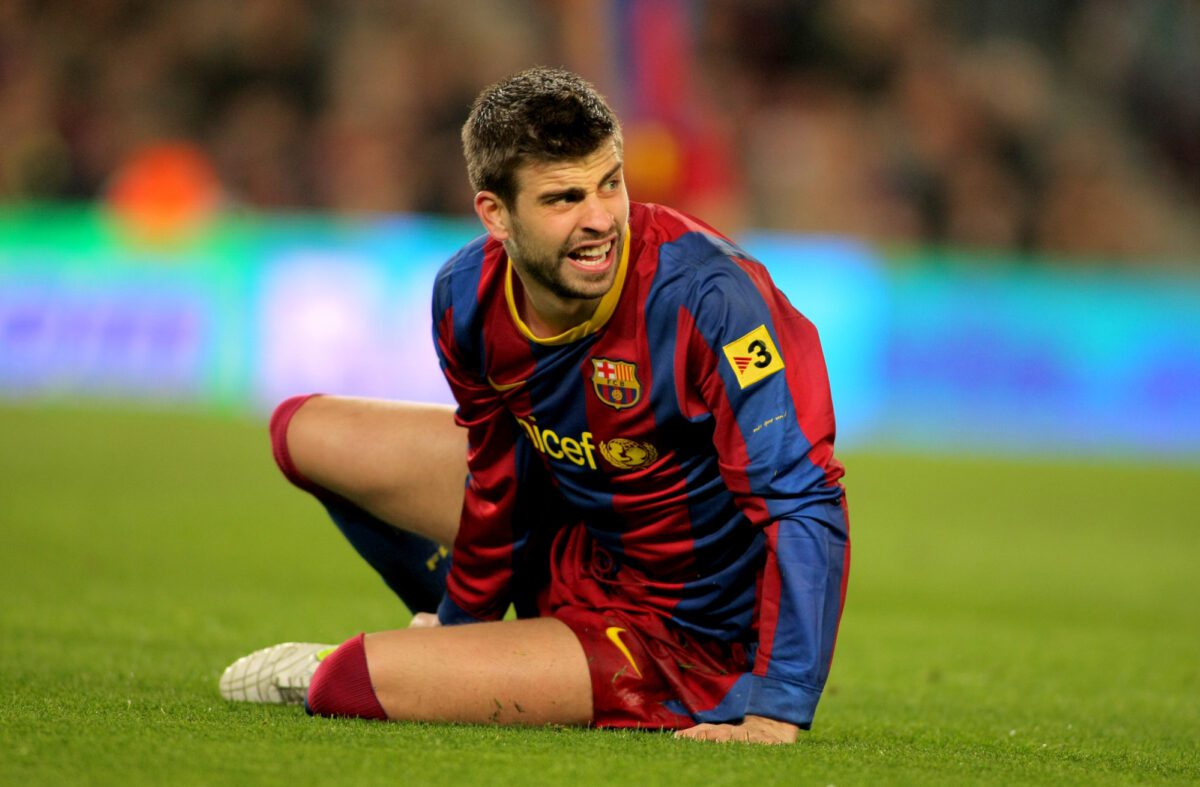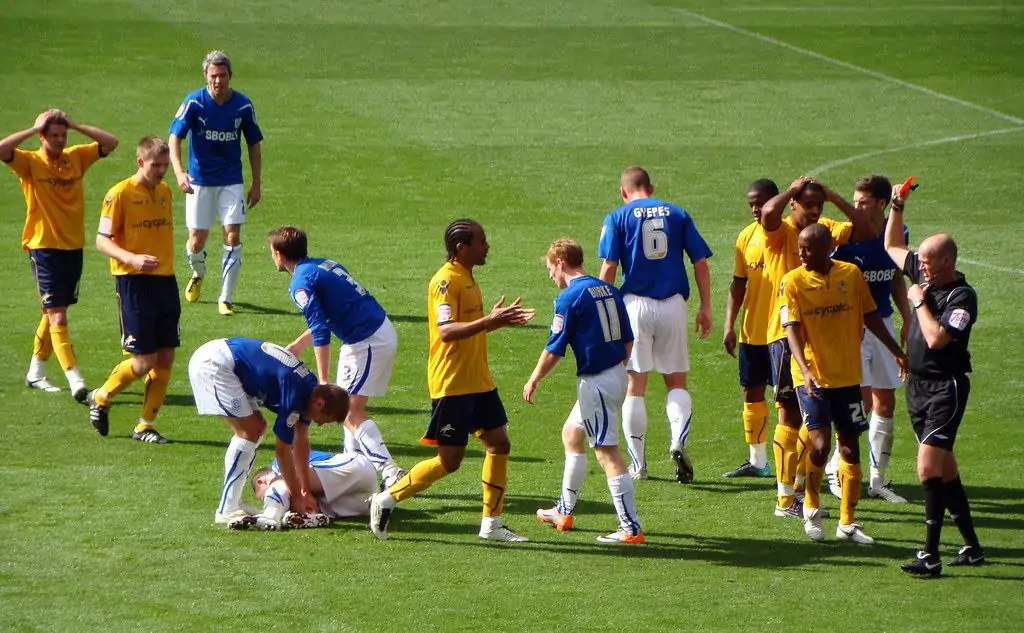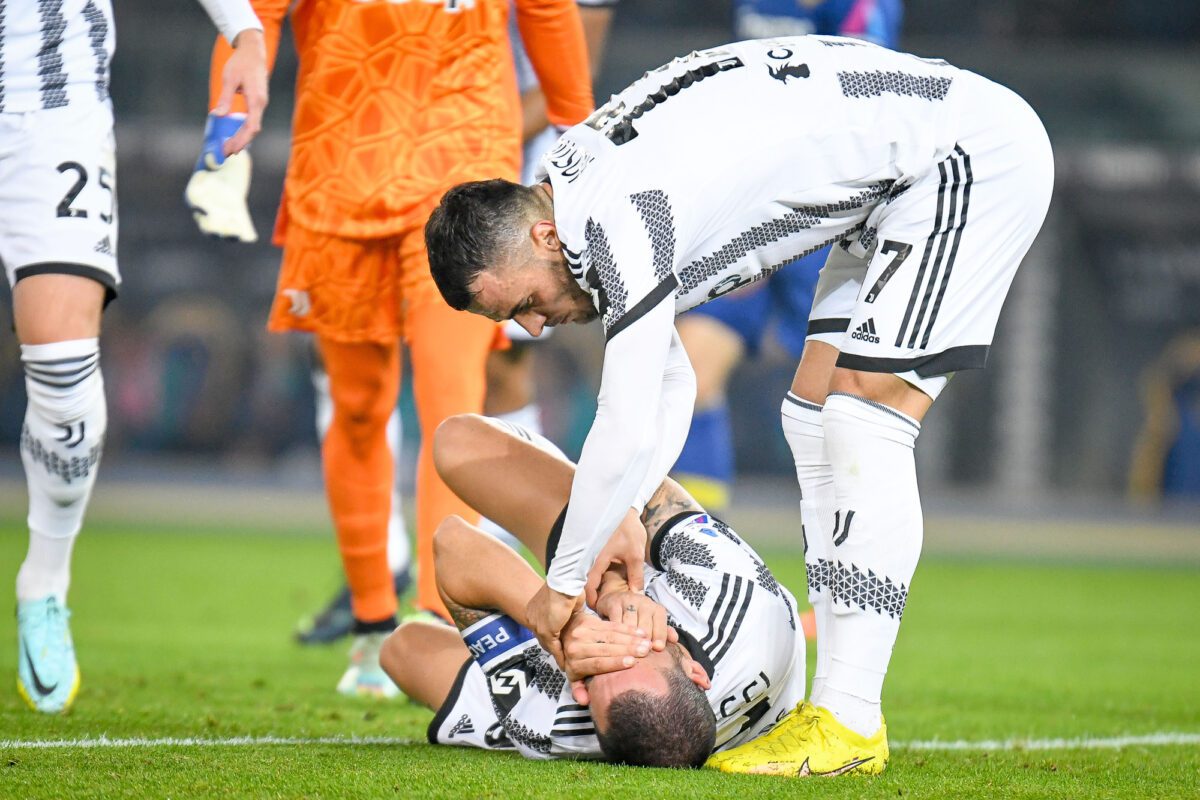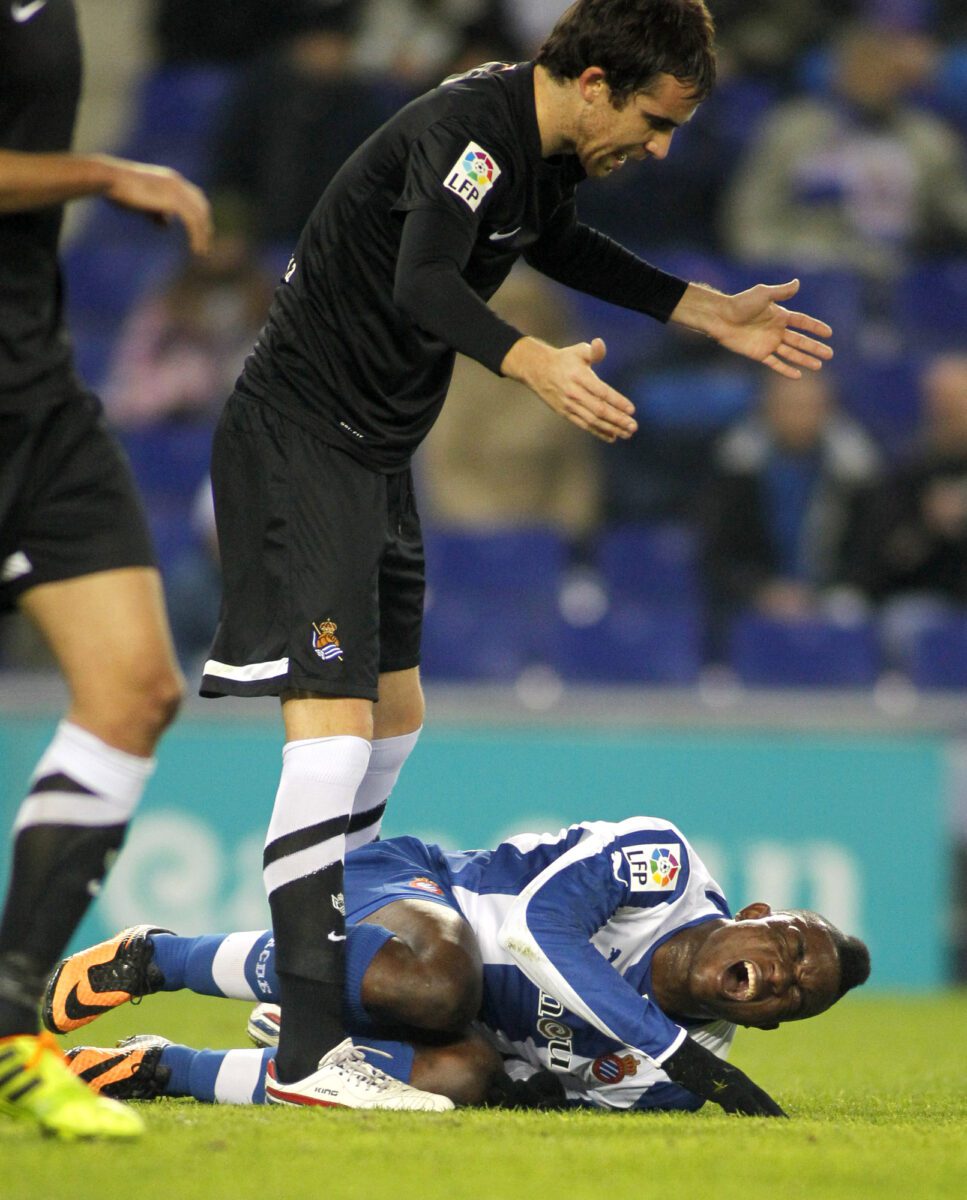Share the post "Why Soccer Players Fake Injuries! (Reasons + Rules)"
There’s a good chance you witnessed at least one or two players faking injuries on a soccer field. Although it is widely criticized and often cited as fans’ least favorite aspect of the sport, faking injury is now a genuine part of the game.
A condemned action in the beautiful game, so why do soccer players fake injuries? This article examines soccer’s dark art of faking injuries, exploring why players flop.
The main areas we touch on include:
- 4 Key reasons why players fake injuries
- What faking is called
- The rules for faking
- MLS punishment for faking

Why Soccer Players Fake Injuries
Soccer players fake injuries to gain an advantage over their opponents. Unfortunately, faking injuries is now part and parcel of the game.
Today, players drop at the slightest contact, often adding dramatic flair to the situation by rolling around or crying out “in pain”. While their reasons might be unethical, a strategy is involved in faking injuries.
Players who jump on the ground or fake an injury try to deceive the referee. There are four main reasons for doing this:
1. To Win a Free Kick or Penalty
The main objective of faking an injury is not to convince other players that you’re hurt. Players fall to the ground pretending to be hurt to trick the referee into thinking they were fouled.
Going down opportunistically in the opponent’s penalty box can result in a penalty awarded to the attacking team, leading to an easy scoring chance.
If players realize they are unlikely to score or take advantage of an attacking position, they may fake an injury to earn a free kick in a promising position.
Free kicks near the opponent’s goal can present goal-scoring opportunities from a direct shot or cross.
2. To Stop a Counterattack
Losing possession can make the team vulnerable to a swift counterattack. A player may fall to the ground and fake an injury in a desperate attempt to stop play after being dispossessed.
A referee can bring the play to a halt if a player is deemed to have a severe injury, whether or not the opposition is in an advantageous position.
Head injuries, broken bones, loss of consciousness, severe wounds, or a heavy collision may be considered serious. Referees may refrain from stopping play for minor incidents such as regular contact, a rolled ankle, or muscle cramps.
Faking a severe injury puts pressure on the referee to stop the game, even if they have doubts about its severity.
3. Time-Wasting
Time-wasting is another ugly aspect of the game of soccer. There are several sneaky ways to take valuable seconds off the clock if your team is holding on to a tight lead, particularly when the game is stopped for a foul, goal kick, or throw-in.
Although intentional time-wasting is illegal and can be punished with a yellow card, faking an injury may be hard to detect, making it an effective tactic.
Timekeeping in soccer is quite different from most American sports. Unlike basketball and American football, the clock only stops at half-time and full-time whistles, indicating the end of either half.
Referees are responsible for keeping track of delays to the game and adding extra time (called additional time or injury time) to the end of both halves to make up for stoppages.
However, with so many other responsibilities, it can be difficult for the referee to track every stoppage accurately.
Players often fake injury to slow the game, waste time, and stall the opposition’s momentum. Teams generally become frustrated when opponents waste time, causing them to lose focus.

4. To Get An Opponent Booked or Sent Off
As you’re probably aware, certain fouls are punished with yellow and red cards. A yellow card is a warning, while a red card means a player is permanently ejected from the game and cannot be replaced by a substitute. Two yellow cards equal a red.
Sometimes players will fake an injury to get an opponent yellow or red-carded. This type of injury faking is particularly prevalent when a player has already been booked.
Knowing that their opponent is on a yellow card, a player might fake an injury hoping that the referee presents a second yellow and sends them off. One of the most common ways modern players fake an injury is by going to the ground after competing for a header.
On too many occasions, we’ve seen players crumble to the floor, indicating to the referee that they’ve been elbowed, trying to get their opponent yellow or red-carded.
While this is a shameful act, it is common in today’s game. Although referees don’t always fall for fake injuries by awarding free kicks, penalties, or yellow and red cards, they often struggle to tell whether an injury is genuine.

What Is It Called When Soccer Players Fake Injuries?
Several words describe faking an injury in soccer, such as flopping or diving.
- In the United States, fans call it ‘flopping’, the same word used for faking an injury or exaggerating contact in basketball.
- In Europe and the rest of the world, it is called ‘diving’, due to the dramatic way many players fall to the ground.
Under the Official Laws of the Game, governed by IFAB, attempts to deceive the referee by feigning an injury or pretending to be fouled is called ‘simulation’.
By definition, simulation means the action of pretending or deception.
Punishment For Faking Injuries
If a player is deemed to be faking an injury or is caught trying to deceive the referee, the punishment is a yellow card. Simulation comes under IFAB Law 12: Fouls and Misconduct, and is seen as unsporting behavior.
Many fans feel that this punishment isn’t severe enough and that players should be given red cards for diving. In the Premier League, there have been calls for retrospective bans for flopping offenders.
The idea is that a regulatory panel would review instances from games after the fact to determine if players intentionally faked injuries.
Offending players would then be fined and banned for a certain number of games.
First time offense
It was proposed that a first-time offense would be punished by a 1-match ban and that repeat offenders would be punished more severely.
While players have received bans for diving in the past, an official system for punishing this type of offense has never been established.
Cristiano Ronaldo Flopping
High-profile players have received red cards for simulation, including Cristiano Ronaldo, during the 2017 Supercopa de España between Real Madrid and Barcelona.
The Super Cup is an annual competition contested over two legs between the previous winners of La Liga and Copa Del Rey.
The incident, which occurred in the first leg of the tournament, was a major topic of controversy as Ronaldo appeared to be off-balance and made contact with Barcelona defender Samuel Umtiti before falling to the turf.
Most observers agreed that although the contact was not enough to award Ronaldo a penalty, he did not dive.
Nonetheless, the referee awarded Barcelona a free-kick and gave Ronaldo his second yellow card, swiftly followed by a red. This meant he would be suspended for the second leg.
In frustration, Ronaldo shoved the referee!
While Real Madrid may have had grounds for an appeal for the alleged diving incident, the shove earned Ronaldo a 5 game suspension, so any attempt to rescind the card would have been futile.
Check out the incident and see for yourself. And, of course, enjoy Cristiano’s wondergoal while you’re at it! Do you think the red card was warranted?
Fortunately for Real Madrid, they not only managed to hold on to their 2-1 lead but also went on to score a third and take home a 3-1 victory.
Even without their talismanic striker for the second leg, Real was victorious, winning the game 2-0, and earning a 5-1 aggregate win as Supercopa champions.
Check out Cristiano Ronaldo’s gameday cleats: the Nike Superfly Elite.
Here are some more red card incidents as a result of diving.
The MLS Disciplinary Commission: Rules On Flops
Major League Soccer is leading the way in eradicating simulation from the sport. The MLS reviews instances and plays after games through its disciplinary committee to determine whether further disciplinary action is needed.
The league established this committee to ensure player safety and preserve the integrity and reputation of Major League Soccer.
It comprises former MLS players, a former coach, and a former referee, ensuring a balanced viewpoint on all on-field misconduct.
The committee is allowed to review and discipline players and coaching staff under 3 parameters.
- Parameter 1: if the in-game officials don’t witness an incident, resulting in no disciplinary action is taken on the field. For example, an off-the-ball altercation that the referee doesn’t see.
- Parameter 2: if the in-game officials handle the incident on the field, the committee may still see the need to add further disciplinary action.
- Parameter 3: if the in-game officials see an incident but do not issue a punishment for clear simulation, the committee can issue cards and suspensions.
Essentially, under parameter 3, the MLS Disciplinary Commission can review simulation instances, then suspend, fine, and punish culpable players.
This approach has proved very successful, contributing to a fairer and cleaner league.
Although the English FA and FIFA, two major organizations in world soccer, have made efforts to eradicate simulation from the game, they have made very little headway.
How has the MLS had such success with its efforts?
Perhaps it is due to the American audience. While most fans agree that flopping has no place in the game, US-based supporters tend to have stronger feelings on the matter than their European counterparts.
Diving has never been welcome in the MLS, and they’re doing an excellent job of keeping it that way.
“I think a vast majority of North American soccer fans and sports fans in general view the attempt to influence a referee decision through these means as unsightly or even unacceptable.”
Nelson Rodriguez , former MLS executive vice president of competition, technical and game operations Nelson Rodriguez .

Why Do Soccer Players Act So Dramatic?
Soccer players generally act so dramatically to grab the attention of the referee. The referee might not call a foul if they rode the challenge and attempted to stay on their feet.
Rolling around on the ground and yelling ensures the referee will notice, often increasing their chances of earning a foul.
Today, it’s hard to tell if a player has genuinely suffered a horrific injury or is acting dramatically to get a ref’s attention.
Is Faking an Injury Always Bad?
Intentionally cheating in sports is always frowned upon. Blatant diving to gain an unfair advantage over your opponent has no place in soccer.
However, it has become widely accepted that players are entitled to “go down” or exaggerate contact if they are fouled to make sure they earn a free kick or penalty.
For example, if a striker feels a push in their back in the penalty box, more often than not, they will fall to the floor to make it clear that they have been fouled.
Technically, exaggerating contact to win a foul isn’t simulation or faking an injury, but it isn’t 100% honest.
Opinions are divided as to whether or not this type of sly gamesmanship should be legal. When you consider the speed of the professional game and the difficulty referees have to keep up with all actions, can you blame a player for making sure fouls are called?
If a player does everything in their power to stay on their feet when tackled, there is a good chance that referees would miss fouls on occasion, putting the honest player at a disadvantage.
The lines are becoming increasingly blurred regarding the level of contact that warrants a foul. However, VAR is helping referees to spot missed fouls or to reverse unfair decisions after the fact.
VAR and review committees, like the one established by the MLS, seem to be the most effective methods for stamping out fake injuries from soccer in the future.
Worst Soccer Fake Injuries
Instant replay has provided us with some highly entertaining dives over the years. While nobody wants to see their team lose out because of a cheat, watching players embarrass themselves by flopping can be enjoyable.
Sports Most Fake Injuries
Most sports fans agree that faking injuries or flopping is most prevalent in soccer and basketball.
However, it’s interesting to note that basketball and soccer account for some of the highest sports-related injuries in the United States annually.
Share the post "Why Soccer Players Fake Injuries! (Reasons + Rules)"
Joel is a seasoned soccer journalist and analyst with many years of experience in the field. Joel specializes in game analysis, player profiles, transfer news, and has a keen eye for the tactical nuances of the game. He played at various levels in the game and coached teams - he is happy to share his insight with you.



